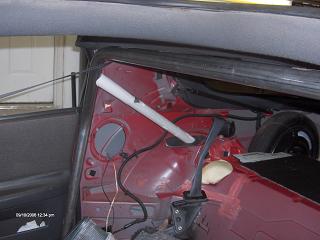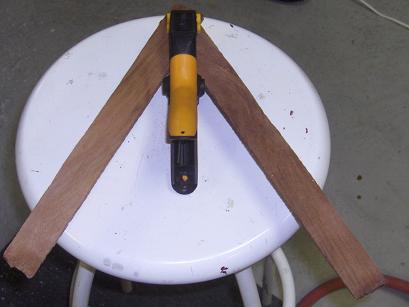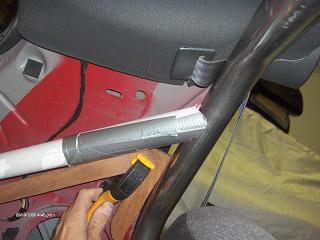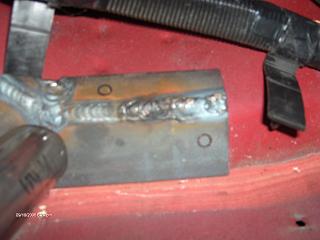<prev Roll
Bar
Main Pads Fitment
Weld Paint Install
next>
Fitment
Believe it or not, it actually took more time test fitting the roll
bar, and deciding where to exactly place it, measuring, etc., than
anything else.
This is a plastic pipe the same diameter as the roll bar tubing. I
slipped a tube of paper over the end so I could adjust the length and
the angle of the end cut easily. This turned out to be a very valuable
template for making the real tube.

Here you see my plastic tube doing a test fit from the main hoop to a
rear fenderwell pad. The straight tube from the main hoop to the pad
made for a direct path and good looking install. Many installs bend the
tube so it meets the main hoop and the pad at right angles. It turns
out if you do that, welding and bolting the pad is easier. I plan to
do things that way on my next roll bar install.

Why bolt to the top of the fender wells? Many cars do this, but most
Camaro installs run these stays further back to the flat area above the
gas tank (which is above the rear axle), or through the rear speaker
grills. There are advantanges and disadvantages to both approaches.
Advantages and disadvantages to connecting the stays to the flat gas
tank area:
- Flat pads
- You don't need to remove the plastic interior side panels
- I think there might be a risk of the stays pushing into the gas
tank in a severe crash (or the bolts into the tank for bolt-in);
although for a wreck this bad you well could have bigger worries!
- Longer stays are needed
- Trunk space is compromised a bit
- You almost have to weld this style in, as you'd have to drop the
gas tank to bolt it in properly
- You can buy this solution already built and engineered from Wolfe
- Connecting higher on the roll bar might be a little stronger
Advantages and disadvantages of running through the rear speaker grills:
- You don't have to remove the passenger side panel, just the
easier to remove trunk side panels
- Robs less trunk and passenger room than the gas tank ones, but
more than the way I did
- You can just buy this solution from Wolfe and don't have to
custom engineer it
- Connecting higher on the roll bar might be a little stronger
Advantages and disadvantages of doing the stays to the tops of the
fenders like I did:
- Straight load path for the stay
- Pad location is near shock attach point, and near horizontal and
vertical metal, for strength
- Stay does not rob trunk or passenger space
- Less obvious from outside the car you have a roll bar
- Rear seatback still folds down
- If you are doing a bolt-in roll bar, it is much easier to bolt
from the fender wells than having to drop the gas tank
- I don't think anyone makes a kit like this, I had to custom
engineer and build it this way
- If you lower the car and put on big wheels there is a chance the
wheels could hit the pad bolt heads when the suspension compresses
enough (since I run F-stock, no lowering allowed, I don't ever
anticipate having this problem)
Here is an angle gauge I made to check the angles between tubes was
within spec (see the rules at Roll Bar
Main). This measured the angle the hole saw needed to cut the tube.
This angle needed to be greater than 30 degrees. The top of the stay
needed to come within 5 inches of the top of the main hoop.


This is a test fit of the main hoop on the pads.

Keywords: Camaro, Firebird, LT1, LS1, autocross, road racing, SCCA,
NHRA, drag racing, safety, roll bar, welding, racing rules
<prev Roll
Bar
Main Pads Fitment
Weld Paint Install
next>